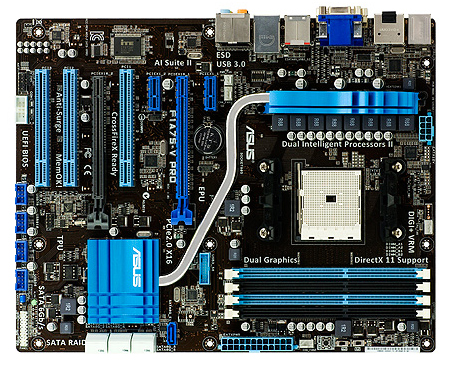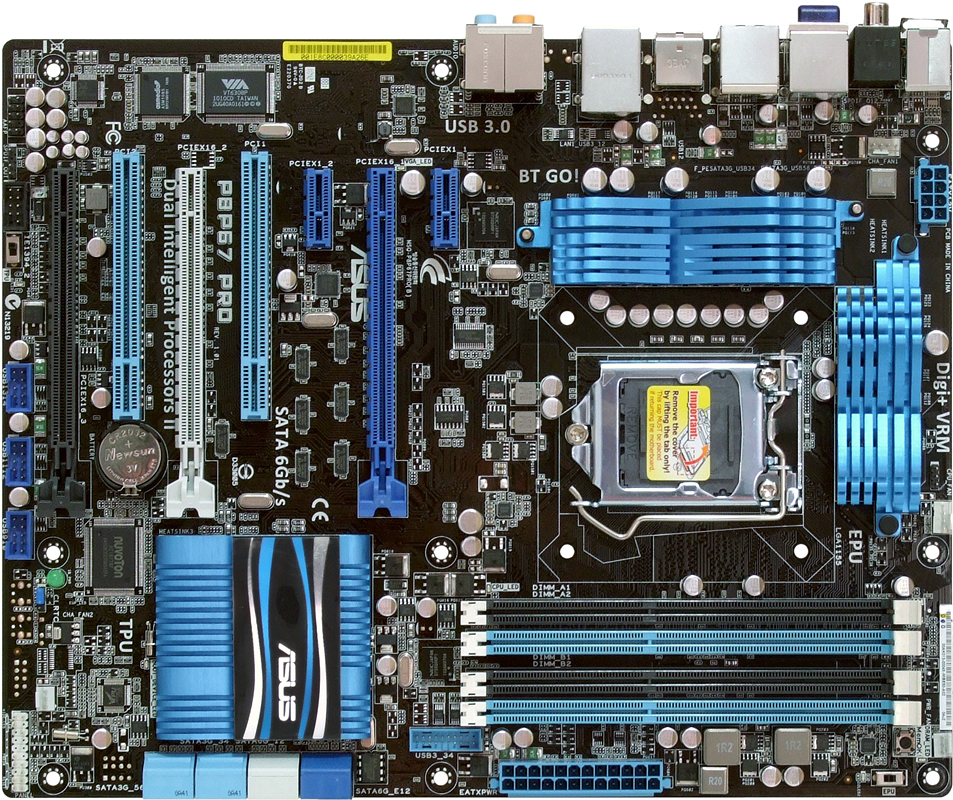Picking A Sub-$200 Gaming CPU: FX, An APU, Or A Pentium?
We really like to hunt down great values in the processor space. Since our last round-up of affordable CPUs, AMD released its Llano-based APUs and Bulldozer-based FX family. Also, Intel introduced a handful of Sandy Bridge-based Pentium chips.
Test System And Benchmarks
Our goal is to demonstrate real-world gaming environments. With that in mind, we chose to test at high detail settings and a resolution of 1920x1080. We're including a Core i5-2500K operating at 4 GHz in order to measure to see if these lower-priced models compare favorably to a higher-end overclocked processor.
Testing LGA 1155-, AM3+-, and FM1-based processors requires three separate platforms. Our trio takes advantage of the same memory and storage subsystem in order to factor out those variables. All test systems employ the fastest single-GPU graphics card available, AMD's Radeon HD 7970. Yes, we realize the $550 choice is unrealistic in a budget-oriented configuration. However, our intention is eliminating potential bottlenecks, and the 7970 helps flesh out each processor's merits.
Our Socket FM1-equipped system centers on Asus' F1A75-V Pro, a full-sized ATX version of the F1A75-M Pro that provided top performance in our A75-based motherboard round-up.
The Socket AM3+-based machine employs Biostar's TA990FXE motherboard, which features the 990FX chipset. It recently proved itself a capable overclocker in our recent System Builder Marathon.
This comparison's LGA 1155 platform is built on Asus’ P8P67 Pro, a board that proved to be the best overclocker in one of our P67 motherboard round-ups.
We weren't able to find an FX-4100 in stock in time for this piece, so we simulate that chip using an FX-6100. By disabling a single Bulldozer module (two integer cores) in the Asus board's firmware, we create the same configuration as the cheaper chip, except for its operating frequency. The FX-4100 runs at 3.6 GHz, but can reach 3.8 GHz via Turbo Core. Since we're unable to manually specify the upper and lower limits for this CPU, though, we set it to run at a constant 3.8 GHz. In theory, this gives our simulated processor a 200 MHz advantage in heavily-threaded workloads. However, that shouldn't apply to most gaming environments. And since this model is unlocked, every FX-4100 can be reliably forced to this clock speed anyway.
| Interface | Socket FM1 | Socket AM3+ | LGA 1155 |
|---|---|---|---|
| CPU/APU | AMD A4-3400 (Llano) 2.7 GHzAMD Athlon II X4 631 (Llano) 2.6 GHzAMD A8-3870K (Llano) 3.0 GHz | AMD Athlon II X3 455 (Rana) 3.3 GHzAMD Athlon II X4 645 (Propus) 3.1 GHzAMD Phenom II X4 955 (Deneb) 3.2 GHzAMD Phenom II X4 980 (Deneb) 3.7 GHzAMD Phenom II X6 1090T (Thuban) 3.2 GHz Base, 3.6 GHz Turbo CoreAMD FX-4100 (Zambezi) 3.6 GHz Base, 3.8 GHz Turbo CoreAMD FX-6100 (Zambezi) 3.3 GHz Base, 3.9 GHz Turbo CoreAMD FX-8120 (Zambezi) 3.1 GHz Base, 3.4 GHz Turbo Core | Intel Pentium G630 (Sandy Bridge) 3.0 GHzIntel Pentium G860 (Sandy Bridge) 2.7 GHzIntel Core i3-2100 (Sandy Bridge) 3.1 GHzIntel Core i5-2400 (Sandy Bridge)3.1 GHz Base, 3.4 GHz Turbo BoostIntel Core i5-2500K (Sandy Bridge) Overclocked to 4.0 GHz |
| Motherboard | Asus F1A75-V ProSocket FM1 Chipset: AMD A75 | Biostar TA990FXESocket AM3+ Chipset: AMD 990FX | Asus P8P67 ProLGA 1155 Chipset: Intel P67 |
| Networking | On-board Gigabit LAN controller | ||
| Memory | OCZ PC3-16000 2 x 2 GB, 1338 MT/s, CL 8-8-8-20-1T | ||
| Graphics | AMD Radeon HD 7970925 MHz GPU, 3 GB GDDR5 at 1375 MHz | ||
| Hard Drive | Western Digital Caviar Black 750 GB 7200 RPM, 32 MB Cache, SATA 3Gb/s | ||
| Power | ePower EP-1200E10-T2 1200 W ATX12V, EPS12V | ||
| Software and Drivers | |||
| Operating System | Microsoft Windows 7 x6, Service Pack 1, KB2645594 and KB2646060 installed | ||
| DirectX | DirectX 11 | ||
| Graphics Drivers | AMD Radeon HD 7970 Win 7 x64 Driver, 1/9/2012 |
| Benchmark Configuration | |
|---|---|
| 3D Games | |
| Metro 2033 | Version 1.0.0.1, Built-In Benchmark |
| Battlefield 3 | Version 1.0.0.0, Operation Swordbreaker, FRAPS runs |
| Elder Scrolls V: Skyrim | Version 1.2.14.0, FRAPS runs |
| DiRT 3 | Version 1.2.0.0, Built-In Benchmark |
| Just Cause 2 | Version 1.0.0.2, Concrete Jungle Benchmark |
| StarCraft 2 | Version: 1.4.2.20141, Tom's Hardware Guide Benchmark |
Get Tom's Hardware's best news and in-depth reviews, straight to your inbox.
Current page: Test System And Benchmarks
Prev Page Can FX, APUs, And Pentium Processors All Game? Next Page Benchmark Results: Elder Scrolls V: SkyrimDon Woligroski was a former senior hardware editor for Tom's Hardware. He has covered a wide range of PC hardware topics, including CPUs, GPUs, system building, and emerging technologies.
-
rambostyrer Another showcase of how disappointing the FX processor is in gaming terms.Reply
the fx-8120 outperformed by the i3-2100 -
compton Given how well my 2500K (and every other 2500K) overclocks, 4.3 is a good every day top turbo bin for 4 cores, and the performance increase vs. power consumption is fantastic. I don't want to add to the chorus of negativity to Bulldozer, but the Phenom II x6 should be kicked down to 32nm soon -- I just can't really think of any reason that someone should by Bulldozer over Intel or an X6. For those that can make use of it's particular strengths, it's price is certainly reasonable. And there is a lot to like about AMD motherboards too. The Phenom might be venerable, but it's not terrible and it's a lot more honest than Bulldozer.Reply
-
Youngmind Does anybody else still think of Pentium 4s and the other flops that Intel created when they see "Pentium?"Reply -
acerace So, is Pentium processors any good? Cause I think I want to upgrade my aging PC to that.Reply -
alidan YoungmindDoes anybody else still think of Pentium 4s and the other flops that Intel created when they see "Pentium?" yea... personally i like numbers, like (name) (number) and that tells me all i need to know about the chip, i dont like (name) (letter-number) and than i have to look crap to figure out what it is, though the whole i series bugs me because of that.Reply
comptonGiven how well my 2500K (and every other 2500K) overclocks, 4.3 is a good every day top turbo bin for 4 cores, and the performance increase vs. power consumption is fantastic. I don't want to add to the chorus of negativity to Bulldozer, but the Phenom II x6 should be kicked down to 32nm soon -- I just can't really think of any reason that someone should by Bulldozer over Intel or an X6. For those that can make use of it's particular strengths, it's price is certainly reasonable. And there is a lot to like about AMD motherboards too. The Phenom might be venerable, but it's not terrible and it's a lot more honest than Bulldozer.
if i had the money, id go i7, i woundt consider anything lower than that.
if i dont have the money, i would only consider the phenom II x4 or x6 line, as i prefer real cores, and the lowest real 4 core intel is over 200$ and the phenoms are 100-150ish.
granted i would wait for pilerdriver. -
Yargnit this really confirms what I've been thinking about the Intel "Pentium" models flying under the radar in the budget market.Reply
The i3-2100 is actually down to $110 on Newegg right now, but at $125 it made the Pentium models an absolute steal. You were paying nearly $40 more for .2 Ghz faster and hyper-threading compared to the G850 between $85-90. A $110 i3-2100 not only addresses this difference much better, but basically kills almost every AMD CPU above that price point, while the Pentium's kill the AMD CPU's below it.
The Phenom 2 x6's (which now appear to be all out of stock) for selective use, and maybe the FX4100 is really all AMD has left that's semi-viable anymore. IT's not looking good for AMD that's for sure. :\ -
de5_Roy thanks a lot for this article. cleared up a lot of things for me.Reply
it was great to see ph ii x4 955 outperform fx in gaming. imo it's the best gaming cpu from amd. fx4100's (and the rest of fx) overclocked (under)performance was sad.
but core i3 2100 and sandy bridge pentiums...damn...
i think intel sorta turned around the old 'pentium vs fx' (for gaming) with sandy bridge pentium vs bulldozer fx.
amd must do better with piledriver and trinity. :sweat: need more competition in cpu arena...
-
LuckyDucky7 @comptonReply
There isn't, and won't ever be, a 32nm die shrink to the Phenom IIs.
Bulldozer is IT, and that's all there is to it.
Maybe Piledriver will have some improvements, but they just won't be enough. Even if they could get IPC parity with the old Phenom IIs they still get run over by Pentiums and the i3-2100.
It will be interesting to see how Trinity performs but I'd be surprised if it wasn't just Bulldozer bolted on to a better GPU; IPC improvements might be there but I doubt they'll be as good as the Phenom IIs. The fall FX releases might get them to parity.
I'd like to see what performance the Ivy Bridge i3 will have; or if Intel will (unlikely) release a K-series for it- thus ensuring that sub-200-dollar overclocking is shelved for at least another 2 years if not indefinitely.

